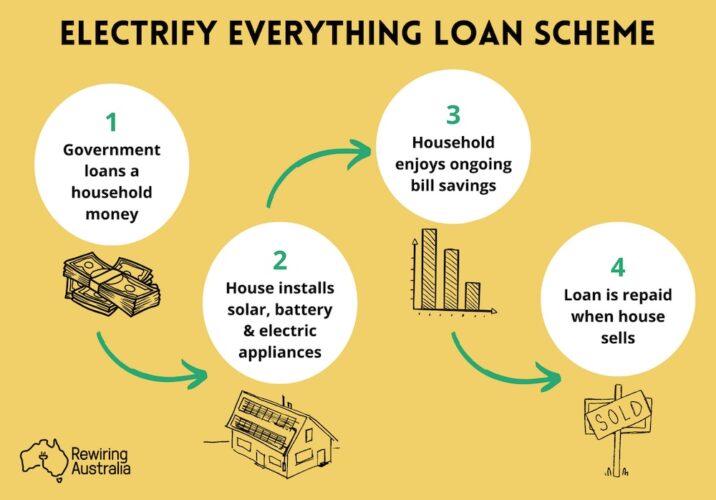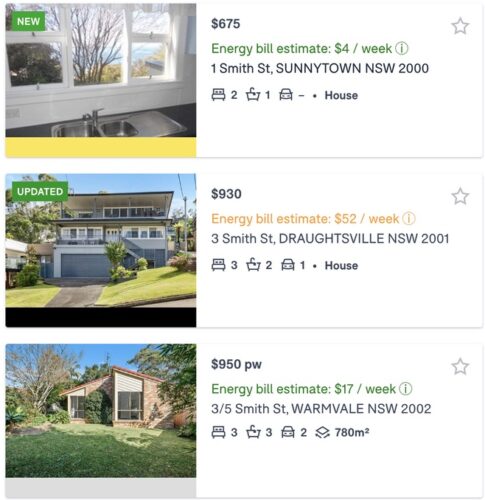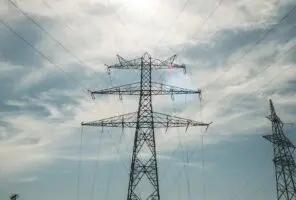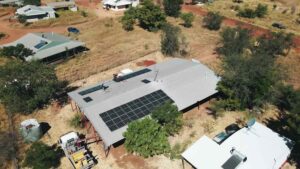Here in 2024, we are in the calm before a storm. It has not yet become obvious to everyone that – because solar-electrified homes are much cheaper and we’re planning to reach net zero by 2050 at the latest – the residential gas networks are going to be wound up, and our homes and cars are all going to be powered by electricity. But more people are noticing.
If we’re going to achieve net zero, we need an exit plan for everyone where no home is left behind on spiralling price rises and the unplanned decline of the fossil energy system. So we’re proposing the Electrify Everything Loan Scheme (EELS). It provides property owners with a loan to install solar, batteries, electric appliances, and other energy and electrification upgrades – and it’s repaid when the property is eventually sold.

This means there’s a simple way to fund the upfront investment in electrification, regardless of savings or access to credit, for the owners who make these decisions about our homes. This includes the low-income pensioners who own their home outright and are unlikely to use debt or savings, working families who are already stretched to the limit with mortgage repayments, or any of the 1.5 million Australians in their own home below the poverty line.
Electrification finance should also include landlords. Not everyone owns their home, but every home has an owner, and it’s that owner who has to make the decision to change appliances and install solar.
Convincing landlords to electrify their properties is how renters will get lower power bills. EELS finance is key, but we’ll need to do more. Renters deserve to know the real cost of living in a home, so we need mandatory disclosure of energy performance on rental ads. Landlords offering homes with high bills will be forced to lower rents to compete with upgraded properties – or get on with the upgrade themselves.

Prospective renters should see the real weekly cost of a home. Image: Rewiring Australia
We also need to introduce minimum standards to compel landlords to make electrification upgrades over time. And if the government is the landlord, then finance isn’t relevant; public housing should be electrified right away for our most vulnerable households.
Once we’ve got the upgrades underway, there’s good news. Switching from all-gas appliances (heating, hot water and cooking) to all-electric with solar and a battery can send energy bills from about $3000 down to $0 (or even into credit).
It’s also a great bang for buck for the taxpayer. Our modelling shows that, if it’s indexed for inflation, the total cost to the budget will be under 6% of the funds loaned. A $10,000 loan would end up costing the government just $577.
When we add up all the solar panels, batteries and appliance upgrades that Australian homes need, the ‘average’ loan required is about $20,000 (some will need more, some less). If 80% of dwellings in Australia did this, it would cost the budget $10.4 billion. That’s a fair bit of money, but it’s almost exactly what the Government spends on the fuel tax credit to make diesel cheaper for mining trucks – every year. The total cost of EELS, in contrast, would be spread over many decades as a small ongoing interest concession while we all enjoy lower energy bills.
Thanks to the budget efficiency of EELS investment, there is still lots of potential for the government to fund rebates or tax incentives where targeted investments are necessary – like social housing, rentals or apartments.
This government-financed proposal is inspired by the HECS scheme, which makes higher education accessible to everyone who wants it, regardless of income. HECS works because the government is a uniquely patient lender. It doesn’t mind waiting for repayment until a time when it works best for the recipient, and it doesn’t see low income recipients as a ‘risk’ that requires charging higher interest rates. EELS works on the same principle: a loan is much safer and more appealing for people (and for the lender) if you know it will only be collected on a day when you’ll be able to pay – in this case, the day someone buys your house.
Everyone is going to need a way off the fossil fuel ship. Our proposal for flexible, safe, government-backed finance that’s accessible across incomes will ensure that upfront costs don’t get in the way of slashing bills and emissions for every property in Australia.
Francis Vierboom is market transformation manager at Rewiring Australia










